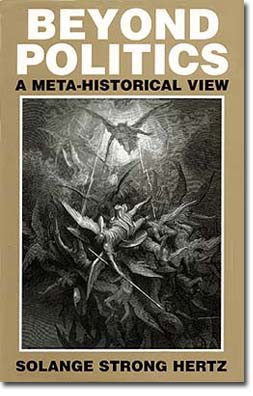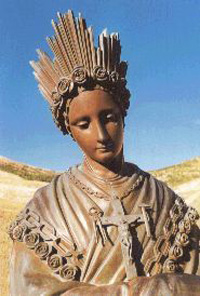She points out the policies of Popes Benedict XV and Pius XI that furthered the revolution of the liberal secular state. It was a Vatican directive that betrayed the heroic Cristeros in Mexico with an order to put down their arms and support the corrupt anti-Catholic Calles government. Later, she notes, secularization took on new vigor at the Second Vatican Council, which was followed by Paul VI’s personal endorsement of the United Nations, “nexus of the godless political apparatus.”
(The Remnant Press: 2003), 291 pp.
With Beyond Politics: A Meta-Historical View, Solange Strong Hertz illustrates that she achieved this maturity of thinking. The book, a collection of essays, is a synthesis of a ripe and experienced Catholic consideration of History, strongly influenced by the studies of French Catholic Fernand Crombette (d. 1970) and the Cercle Scientifique et Historique [CESHE], a group that promotes and develops Crombette’s thinking. It is important to understand what Mrs. Hertz means by Meta-History (from the Greek meta, meaning beyond), a word that is appearing frequently in modern academia with quite different twists. For example, the whole point of Hayden White’s well-known work entitled Metahistory is to show that nothing “is the way it is,” everything is a story, an interpretation of a time, a presentation of an ideology. Since for White every account lacks “complete objectivity,” no account can claim to be true. No truth exists for what he calls the meta-historians. For them, everything is relative. Today this historic relativism has become widespread. Sadly, since Vatican II, the Holy See has included many scholars of this type among its advisers. The opposite is true for Mrs. Hertz. She understands Meta-History as highly consistent and with an absolute meaning. It is History seen from its highest causes, which means from the perspective of God. What matters is God’s plan for man and society in both the religious and temporal spheres. The deeds of man are to be analyzed in view of this. The principal facet of the crystal Mrs. Hertz uses to consider God’s design for man is Divine Revelation. Drawing not only Scriptures more evident passages, she also interprets veiled and mysterious parts looking for their more profound sense and beauty. From these heights, which she describes as a “juncture between time and eternity,” she analyzes History. It is a medieval perspective very attractive to me, even though different from my own. In History there are changes of eras, marked by the implantation of different types of culture, the installment of various forms of government, the domination by different peoples. To the measure that such changes are legitimate, a people, culture, or institution emits a special brilliance that augments the extrinsic glory of God. Here is the key question rarely asked today: Is a change legitimate, in the sense of following the divine plan and increasing the glory of God on earth? To what extent does it represent the fruit of fidelity to Catholic teaching? Or does it, on the other hand, break with the continuity expressed by the upright variety of customs and institutions in the history of a people? Mrs. Hertz asks these questions, and has the courage to give answers that threaten modern man’s assumptions about progress, democracy and science, as well as the revolutionary trio of liberty, equality and fraternity. Americans are not accustomed to this sort of analysis, which makes many of her controversial expositions and bold conclusions even more valuable. Here is one such question: Was the scientific revolution represented by Galileo truly the grand advance in progress it is purported to be? Spurning Scholasticism, the new school upset the true hierarchy of sciences, setting up mathematics over metaphysics and even over theology. Galileo’s revolution was much more than a new hypothesis that the earth revolved around the sun; it challenged a literal acceptance of Divine Scripture and set the foundation for a new “dogma,” that of the supposed infallibility of science, to replace divine revelation as the ultimate source of truth. Whether you agree with Hertz on heliocentrism or not, it is clear that the scientific revolution brought into question the entire scholastic tradition and fostered a growing skepticism about the possibility of certain knowledge. What about the American and French Revolutions, which effectively formalized the separation of religion and state and set the rule of the people over the law of God? Do they really indicate a step forward for History by replacing the medieval Catholic order in which rulers were subject to the Kingship of Christ? Hertz’ answer is quite clear: A government that claims to derive its “just powers” not from God, but from the “consent of the governed” should be condemned, as it firmly was by Pope St. Pius X in his apostolic letter addressed to the French Bishops warning against the error of Christian democracy as manifested in the “Sillon” movement. In an important essay in this book titled “The Tears of the Papacy,” Mrs. Hertz demonstrates the liberal role of the Church in the rise and acceptance of democracy. Concessions to the new republics began with concordats, like that of Pius VII with Napoleon, just after the French Revolution. Leo XIII sealed the fate of the doomed monarchies with his famous “ralliement” in the Encyclical Au milieu des sollicitudes in 1892, which officially put the forces of the Church behind democracy, and doomed the valiant Catholic movements in Europe fighting to restore the traditional monarchy. Ah, some might object, but Mrs. Hertz is criticizing the actions of Popes, and this is not Catholic or good. To this objection she devotes a chapter of response, “Peter’s Policies.” Catholics need to know not only when legitimate authority can be defied, but when it must be defied if God is to be served, she insists. She points out the policies of Popes Benedict XV and Pius XI that furthered the revolution of the liberal secular state. It was a Vatican directive that betrayed the heroic Cristeros in Mexico with an order to put down their arms and support the corrupt anti-Catholic Calles government. Later, she notes, secularization took on new vigor at the Second Vatican Council, which was followed by Paul VI’s personal endorsement of the United Nations, “nexus of the godless political apparatus.” Are Catholics to go along with this “havoc wrought in Christ’s vineyard?” No, Mrs. Hertz responds. What made such destruction possible was blind obedience, a tool specially forged by the devil to serve the ends of the on-going revolution in the last century. As Hertz concludes, “Any degree of political or religious deformation becomes possible through mindless compliance with authority, and History proves papal authority no exception” (p. 221). We are opportunely reminded that Popes can and do commit serious errors in judgment, and can even deny Christ as St. Peter did. And when they do, Catholics are required to resist. Before closing this review on Mrs. Hertz’s notable Beyond Politics: A Meta-Historical View, I would like to make two more brief comments. First, to those critics who complain about the lack of footnotes and sources in some of Mrs. Hertz’ work, I would direct them to this book. She cites valuable sources, especially when she reveals the plots of the secret forces of Freemasonry and the Jewish Kabala to infiltrate the Church. At the end of the book is a concise and interesting bibliography, mostly French works.
After five years of careful examination of the facts surrounding the apparitions, the Church authorized the Cult of Our Lady of La Salette in 1851, and a grand Minor Basilica was built at the site. Notwithstanding, very soon opposition set in and ardent efforts were made to quash the secret entrusted to Melanie, which was finally published in 1873 with an imprimatur of the Bishop of Naples, Italy. It speaks of the period from 1846 to the era of the manifestation of the Antichrist, with the warning that Rome would lose the Faith and become the seat of the Antichrist. Why did such hostility to Melanie’s secret arise? Could it be because it speaks of a crisis inside the Church, of the infiltration of “the abomination into the holy places?” Mrs. Hertz publishes the full text of the message of La Salette, without commentary. As Melanie told her director in 1903, “Souls who are God’s friends can guess the Secret’s meaning without help, and the others won’t want to because it applies to them too closely” (ibid.) And if this were clear at the turn of the century, Mrs. Hertz notes, it is even clearer now for those with eye to see. |


Comments